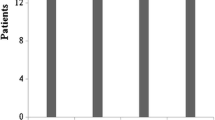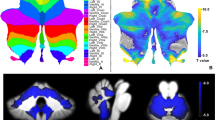Abstract
Background
Subtle cerebellar signs are frequently observed in essential tremor (ET) and may be associated with cerebellar dysfunction. This study aims to evaluate the macrostructural integrity of the superior, middle, and inferior cerebellar peduncles (SCP, MCP, ICP) and cerebellar gray and white matter (GM, WM) volumes in patients with ET, and compare these volumes between patients with and without cerebellar signs (ETc and ETnc).
Methods
Forty patients with ET and 37 age- and gender-matched healthy controls were recruited. Atlas-based region-of-interest analysis of the SCP, MCP, and ICP and automated analysis of cerebellar GM and WM volumes were performed. Peduncular volumes were employed in a multi-variate classification framework to attempt discrimination of ET from controls.
Results
Significant atrophy of bilateral MCP and ICP and bilateral cerebellar GM was observed in ET. Cerebellar signs were present in 20% of subjects with ET. Comparison of peduncular and cerebellar volumes between ETnc and ETc revealed atrophy of right SCP, bilateral MCP and ICP, and left cerebellar WM in ETc. The multi-variate classifier could discriminate between ET and controls with a test accuracy of 86.66%.
Conclusions
Patients with ET have significant atrophy of cerebellar peduncles, particularly the MCP and ICP. Additional atrophy of the SCP is observed in the ETc group. These abnormalities may contribute to the pathogenesis of cerebellar signs in ET.
Key Points
• Patients with ET have significant atrophy of bilateral middle and inferior cerebellar peduncles and cerebellar gray matter in comparison with healthy controls.
• Patients of ET with cerebellar signs have significant atrophy of right superior cerebellar peduncle, bilateral middle and inferior cerebellar peduncle, and left cerebellar white matter in comparison with ET without cerebellar signs.
• A multi-variate classifier employing peduncular volumes could discriminate between ET and controls with a test accuracy of 86.66%.




Similar content being viewed by others
Abbreviations
- AAO:
-
Age at onset
- DTI:
-
Diffusion tensor imaging
- ET:
-
Essential tremor
- ETc:
-
Essential tremor with cerebellar signs
- ETnc:
-
Essential tremor without cerebellar signs
- FTMRS:
-
Fahn-Tolosa-Marin tremor rating scale
- GM:
-
Gray matter
- HC:
-
Healthy controls
- ICP:
-
Inferior cerebellar peduncle
- MCP:
-
Middle cerebellar peduncle
- MRI:
-
Magnetic resonance imaging
- RF:
-
Random forest
- ROC:
-
Receiver operating characteristics
- ROI:
-
Region of interest
- SCP:
-
Superior cerebellar peduncle
- SVM:
-
Support vector machine
- WM:
-
White matter
References
Louis ED, Ferreira JJ (2010) How common is the most common adult movement disorder? Update on the worldwide prevalence of essential tremor. Mov Disord 25:534–541
Nahab FB, Peckham E, Hallett M (2007) Essential tremor, deceptively simple. Pract Neurol 7:222–233
Chandran V, Pal PK (2012) Essential tremor: beyond the motor features. Parkinsonism Relat Disord 18:407–413
Hanajima R, Tsutsumi R, Shirota Y, Shimizu T, Tanaka N, Ugawa Y (2016) Cerebellar dysfunction in essential tremor. Mov Disord 31:1230–1234
Buijink AW, Broersma M, van der Stouwe AM et al (2015) Rhythmic finger tapping reveals cerebellar dysfunction in essential tremor. Parkinsonism Relat Disord 21:383–388
Prasad S, Velayutham SG, Reddam VR, Stezin A, Jhunjhunwala K, Pal PK (2018) Shaky and unsteady: dynamic posturography in essential tremor. J Neurol Sci 385:12–16
Benito-León J, Labiano-Fontcuberta A (2016) Linking essential tremor to the cerebellum: clinical evidence. Cerebellum 15:253–262
Wójcik-Pędziwiatr M, Plinta K, Krzak-Kubica A et al (2016) Eye movement abnormalities in essential tremor. J Hum Kinet 52:53–64
Louis ED (2016) Linking essential tremor to the cerebellum: neuropathological evidence. Cerebellum 15:235–242
Louis ED, Faust PL, Ma KJ, Yu M, Cortes E, Vonsattel JP (2011) Torpedoes in the cerebellar vermis in essential tremor cases vs. controls. Cerebellum 10:812–819
Cerasa A, Quattrone A (2016) Linking essential tremor to the cerebellum-neuroimaging evidence. Cerebellum 15:263–275
Cerasa A, Messina D, Nicoletti G et al (2009) Cerebellar atrophy in essential tremor using an automated segmentation method. AJNR Am J Neuroradiol 30:1240–1243
Nicoletti G, Manners D, Novellino F et al (2010) Diffusion tensor MRI changes in cerebellar structures of patients with familial essential tremor. Neurology 74:988–994
Novellino F, Nicoletti G, Cherubini A et al (2016) Cerebellar involvement in essential tremor with and without resting tremor: a diffusion tensor imaging study. Parkinsonism Relat Disord 27:61–66
Fang W, Chen H, Wang H et al (2016) Essential tremor is associated with disruption of functional connectivity in the ventral intermediate nucleus--motor cortex--cerebellum circuit. Hum Brain Mapp 37:165–178
Saini J, Bagepally BS, Bhatt MD et al (2012) Diffusion tensor imaging: tract based spatial statistics study in essential tremor. Parkinsonism Relat Disord 18:477–482
Lenka A, Bhalsing KS, Panda R et al (2017) Role of altered cerebello-thalamo-cortical network in the neurobiology of essential tremor. Neuroradiology 59:157–168
Klein JC, Lorenz B, Kang JS et al (2011) Diffusion tensor imaging of white matter involvement in essential tremor. Hum Brain Mapp 32:896–904
Bagepally BS, Bhatt MD, Chandran V et al (2012) Decrease in cerebral and cerebellar gray matter in essential tremor: a voxel-based morphometric analysis under 3T MRI. J Neuroimaging 22:275–278
Sharifi S, Nederveen AJ, Booij J, van Rootselaar AF (2014) Neuroimaging essentials in essential tremor: a systematic review. Neuroimage Clin 5:217–231
Deuschl G, Bain P, Brin M (1998) Consensus statement of the Movement Disorder Society on Tremor. Ad Hoc Scientific Committee. Mov Disord 13 Suppl 3:2–23
Fahn S, Tolosa E, Marín C (1993) Clinical rating scale for tremor. In: Jankovic J, Tolosa E (Eds) Parkinson’s disease and movement disorders. Baltimore: Williams and Wilkins pp 271–280
Bhalsing KS, Kumar KJ, Saini J, Yadav R, Gupta AK, Pal PK (2015) White matter correlates of cognitive impairment in essential tremor. AJNR Am J Neuroradiol 36:448–453
Prasad S, Rastogi B, Shah A et al (2018) DTI in essential tremor with and without rest tremor: two sides of the same coin? Mov Disord. https://doi.org/10.1002/mds.27459
Bhalsing KS, Upadhyay N, Kumar KJ et al (2014) Association between cortical volume loss and cognitive impairments in essential tremor. Eur J Neurol 21:874–883
Prasad S, Shah A, Bhalsing KS et al (2019) Abnormal hippocampal subfields are associated with cognitive impairment in essential tremor. J Neural Transm (Vienna) 126:597–606
van Baarsen KM, Kleinnijenhuis M, Jbabdi S, Sotiropoulos SN, Grotenhuis JA, van Cappellen van Walsum AM (2016) A probabilistic atlas of the cerebellar white matter. Neuroimage 124:724–732
Ou Y, Sotiras A, Paragios N, Davatzikos C (2011) DRAMMS: deformable registration via attribute matching and mutual-saliency weighting. Med Image Anal 15:622–639
Fischl B (2012) FreeSurfer. Neuroimage 62:774–781
Chen T, Guestrin C (2016) Xgboost: a scalable tree boosting system. Proceedings of the 22nd ACM SIGKDD International Conference on Knowledge Discovery and Data Mining. ACM, pp 785–794
Ho TK (1995) Random decision forests. Proceedings of 3rd International Conference on Document Analysis and Recognition. IEEE, pp 278–282
Smola AJ, Scholkopf B (2004) A tutorial on support vector regression. Stat Comput 14:199–222
Nichols T, Hayasaka S (2003) Controlling the familywise error rate in functional neuroimaging: a comparative review. Stat Methods Med Res 12:419–446
Buijink AW, Broersma M, van der Stouwe AM et al (2016) Cerebellar atrophy in cortical myoclonic tremor and not in hereditary essential tremor-a voxel-based morphometry study. Cerebellum 15:696–704
Caligiuri ME, Arabia G, Barbagallo G et al (2017) Structural connectivity differences in essential tremor with and without resting tremor. J Neurol 264:1865–1874
Shin DH, Han BS, Kim HS, Lee PH (2008) Diffusion tensor imaging in patients with essential tremor. AJNR Am J Neuroradiol 29:151–153
Buijink AW, Broersma M, van der Stouwe AM et al (2015) Rhythmic finger tapping reveals cerebellar dysfunction in essential tremor. Parkinsonism Relat Disord 21:383–388
Obeso I, Cerasa A, Quattrone A (2015) The effectiveness of transcranial brain stimulation in improving clinical signs of hyperkinetic movement disorders. Front Neurosci 9:486
Kamble N, Netravathi M, Pal PK (2014) Therapeutic applications of repetitive transcranial magnetic stimulation (rTMS) in movement disorders: a review. Parkinsonism Relat Disord 20:695–707
Okamoto K, Tokiguchi S, Furusawa T et al (2003) MR features of diseases involving bilateral middle cerebellar peduncles. AJNR Am J Neuroradiol 24:1946–1954
Akhlaghi H, Corben L, Georgiou-Karistianis N et al (2011) Superior cerebellar peduncle atrophy in Friedreich’s ataxia correlates with disease symptoms. Cerebellum 10:81–87
Morales H, Tomsick T (2015) Middle cerebellar peduncles: magnetic resonance imaging and pathophysiologic correlate. World J Radiol 7:438–447
Snell RS (2010) Clinical neuroanatomy. Lippincott Williams & Wilkins. Philadelphia
Haines DE, Dietrichs E (2012) The cerebellum - structure and connections. Handb Clin Neurol 103:3–36
Roostaei T, Nazeri A, Sahraian MA, Minagar A (2014) The human cerebellum: a review of physiologic neuroanatomy. Neurol Clin 32:859–869
Benito-León J, Alvarez-Linera J, Hernández-Tamames JA, Alonso-Navarro H, Jiménez-Jiménez FJ, Louis ED (2009) Brain structural changes in essential tremor: voxel-based morphometry at 3-Tesla. J Neurol Sci 287:138–142
Funding
This study has received funding by Department of Science and Technology – Science and Engineering Research Board (DST-SERB) (ECR/2016/000808) who provided partial funding for setting up the computing facility.
Author information
Authors and Affiliations
Corresponding author
Ethics declarations
Guarantor
The scientific guarantor of this publication is Dr. Pramod Kumar Pal.
Conflict of interest
The authors of this manuscript declare no relationships with any companies whose products or services may be related to the subject matter of the article.
Statistics and biometry
No complex statistical methods were necessary for this paper.
Informed consent
Written informed consent was obtained from all subjects (patients) in this study.
Ethical approval
Institutional Review Board approval was obtained.
Study subjects or cohorts overlap
Some study subjects are part of the cohort have been part of previous studies from our group:
Prasad S, Shah A, Bhalsing KS, Kumar KJ, Saini J, Ingalhalikar M, Pal PK. Abnormal hippocampal subfields are associated with cognitive impairment in Essential Tremor. Journal of Neural Transmission. 2019 Mar 19:1–0.
Prasad S, Rastogi B, Shah A, Bhalsing KS, Ingalhalikar M, Saini, J, Yadav R, Pal PK. DTI in essential tremor with and without rest tremor: Two sides of the same coin? Movement Disorders. 2018 September 28.
Bhalsing KS, Kumar KJ, Saini J, Yadav R, Gupta AK, Pal PK. White matter correlates of cognitive impairment in essential tremor. AJNR Am J Neuroradiol. 2015;36(3):448–45.
Bhalsing KS, Upadhyay N, Kumar KJ et al (2014) Association between cortical volume loss and cognitive impairments in essential tremor. Eur J Neurol 21:874–883.
Methodology
• Prospective
• Case-control study
• Performed at one institution
Additional information
Publisher’s note
Springer Nature remains neutral with regard to jurisdictional claims in published maps and institutional affiliations.
Rights and permissions
About this article
Cite this article
Prasad, S., Pandey, U., Saini, J. et al. Atrophy of cerebellar peduncles in essential tremor: a machine learning–based volumetric analysis. Eur Radiol 29, 7037–7046 (2019). https://doi.org/10.1007/s00330-019-06269-7
Received:
Revised:
Accepted:
Published:
Issue Date:
DOI: https://doi.org/10.1007/s00330-019-06269-7




